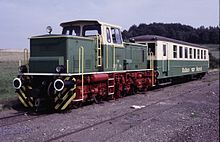MaK 400 BB
| MaK 400 BB as RhB Gm 4/4 | |
|---|---|
|
Gm 4/4 241 in Untervaz
|
|
| Numbering: | LAW D 8, Brohltalbahn D 4, RhB 241 |
| Number: | 1 |
| Manufacturer: | MaK |
| Year of construction (s): | 1959 |
| Type : | B'B 'ie |
| Gauge : | 860 mm / 1000 mm |
| Length over buffers: | 9680 mm |
| Height: | 3400 mm |
| Width: | 2445 mm |
| Trunnion Distance: | 4000 mm |
| Bogie axle base: | 1700 mm |
| Total wheelbase: | 5860 mm |
| Service mass: | 36 t |
| Top speed: | 30 km / h / 50 km / h * |
| Installed capacity: | 2 × 147 kW (2 × 200 PS) / 136 kW * |
| Driving wheel diameter: | 850 mm |
| Motor type: | 2 × MWM RHS518S / Cummins KT 19-L * |
| Rated speed: | 1800 rpm |
| Power transmission: | hydraulic |
| Tank capacity: | 2000 l |
| Locomotive brake: | Compressed air |
| Train brake: | Suction air |
| * since 1999 | |
The MaK 400 BB is a four-axle diesel locomotive that was built in 1959 by Maschinenbau Kiel (MaK). Today it is in use with the Rhaetian Railway (RhB) with the designation Gm 4/4 and road number 241 .
history

The locomotive was initially delivered by MaK in 1959 to the Alsen Portland cement works in Lägerdorf near Itzehoe (Germany). It originally had a track width of 860 mm. In 1967 it came to the Aurich Kreisbahn and was given the designation D 8 there. For this purpose, it was converted to meter gauge at Schöma and received additional pulling and pushing devices for standard-gauge wagons for roll-head traffic . However, it was soon no longer used to capacity and was shut down in October 1969 after a clutch failure. In 1971, after having been repaired by MaK in Moers, it came to the Brohl Valley Railway , where it was in use with the designation D 4 until 1986, mainly as a reserve and for the "Vulkan-Express".
In 1989 it came to the Rhaetian Railway via a vehicle dealer for the transport of demolition material for the construction of the Vereina tunnel . The locomotive was adapted to the RhB standards and designated with the number 241. In the first few years it proved to be very prone to failure, so that in 1999 it was decided to carry out a major renovation in the main workshop (HW) Landquart . The chassis, frame and superstructure were largely retained, engines, gearboxes, controls and cooling systems were replaced, and the driver's cab was also aligned with the other RhB locomotives. Since the renovation, it has mostly been used in the shunting service in Untervaz without any problems .
Description and technology
The MaK 400 BB has a central driver's cab and two stems of unequal length. Two water-cooled motors act on a hydraulic transmission that drives all four axles mounted in two bogies. The original MWM engines had an output of 147 kW each . The two new diesel engines each have an output of 136 kW, which gives the machine an hourly pulling force of 80 kN at 20 km / h. They are housed next to each other in the longer front end and are each connected to the transmission via a converter from Twindisc, which is located in the middle between the bogies.
The locomotive has a compressed air brake, and there is also a suction air brake for the cars. The compressor, the compressed air and diesel tanks and the battery are housed in the rear, shorter front end.
Further developments of this locomotive are the DB series V 51 and DB series V 52 , which were built by Gmeinder under a MaK license .
Web links
- The MaK 400 BB at loks-aus-kiel.de
literature
- Claude Jeanmaire: Rhaetian Railway. Main network traction vehicles . Villigen 1995. ISBN 3-85649-219-4
- Wolfgang Finke, Hans Schweers: The vehicles of the Rhaetian Railway . Volume 3: Locomotives, railcars, tractors. 1889-1998 . Schweers + Wall, Aachen 1998, ISBN 3-89494-105-7 .
- Hinrich Rudolfsen, Wolf-Jobst Siedler: The Leer-Aurich-Wittmund small train . Kenning Verlag, Nordhorn 1997, ISBN 3-927587-46-X , p. 116-118 .
Individual evidence
- ↑ Lok Magazin 7/2019, p. 60.
- ↑ LokMagazin 6/2016, p. 51.

